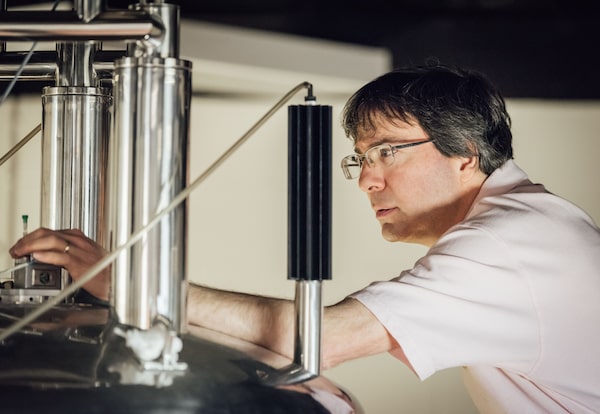
Lewis Kay, a molecular biophysicist at the University of Toronto, has been awarded this year's Gerhard Herzberg Canada Gold Medal for Science and Engineering, including a $1-million research grant, for his studies of proteins and other structures within cells.Martin Lipman/NSERC
In 1990, Lewis Kay was a Canadian postdoctoral researcher working in the United States and considering his job prospects. On the table were two offers: one from Johns Hopkins University in Baltimore and one from the University of Toronto.
After soberly considering the pros and cons, Dr. Kay, a molecular biophysicist, and his wife, Julie, who is also a scientist, decided the two offers were equally appealing. Feeling at a crossroads, Dr. Kay finally asked Julie to flip a coin. Heads would represent Hopkins and a professional future in the United States, while tails would mean Toronto.
She flipped the coin and it came up heads.
Dr. Kay looked as his wife and, after a pause, said, “Flip it again.”
“I wanted to come back to Canada,” Dr. Kay said. “I feel very strongly committed to pushing science forward and I wanted to do it my way, in my country.”
Nearly 28 years later, Dr. Kay, now a full professor at the University of Toronto, has been named this year’s winner of the Herzberg gold medal, Canada’s top science prize outside the medical domain. The prize, awarded by the Natural Sciences and Engineering Research Council (NSERC), Canada’s main science-funding agency, recognizes work of sustained excellence and overall influence across a researcher’s career. It comes with a $1-million grant to be applied to research at a Canadian university.
Dr. Kay, who is also affiliated with Toronto’s Hospital for Sick Children (SickKids), is known for his work in nuclear magnetic resonance, which involves the use of giant machines and powerful magnetic fields to probe the three-dimensional shapes of molecules. Although the technique is rooted in physics, its applications include understanding the functions of proteins and other cellular structures that are closely tied to human health and disease.
The recognition comes less than a year after Dr. Kay received a prestigious Canada Gairdner International Award, considered one of the world’s top medical-research prizes. At a reception last fall, he stressed the need for public support of research and called on the government to increase support for early career scientists who are “equally as committed, far brighter and armed with the passion and determination to make the next generation of discoveries that our society so much depends on.”
Dr. Kay, who is originally from Alberta and received his PhD from Yale University, will receive the Herzberg medal from Governor-General Julie Payette at a reception in Ottawa on Tuesday.
He will be joined by other scientists and research teams who will take part in the council’s annual awards ceremony. That includes chemist Michael Organ, this year’s winner of the Polanyi prize, for his recent advances in the creation of chemical catalysts for a wide range of applications including pharmaceuticals and organic LEDs for next-generation screen displays.
Dr. Organ, who grew up on a family farm in southwestern Ontario, originally went to study agriculture at the University of Guelph. During a summer undergraduate research job that Dr. Organ said, “I basically got because I could drive a tractor,” he realized he had an aptitude for science. After receiving his PhD, his career path led to positions at Stanford and Purdue universities before he came to York University in Toronto where, in 2004, his work produced a breakthrough in catalyst synthesis. In 2016, he became director of the University of Ottawa’s Centre for Catalysis Research and Innovation.
NSERC president Mario Pinto said both winners have in common the development of new tools and methods in basic science, which they have used to pursue goals that are of broad relevance to society.
“They were bright enough to recognize and understand the potential of their discoveries,” he added.
This year’s slate of winners continues a trend that has overwhelmingly seen male researchers claim Canada’s top science prizes, a by-product Dr. Pinto said of the smaller number of senior female scientists who win federal funding and the lower rate at which they are nominated by their institutions. This year, for example, women accounted for only two out of the 14 nominations for the Herzberg medal.
Dr. Pinto noted that six prizes which recognize the most promising young scientists in Canada are split evenly between men and women this year.
 Ivan Semeniuk
Ivan Semeniuk